
Psidium is a genus of trees and shrubs in the family Myrtaceae. It is native to warmer parts of the Western Hemisphere. Many of the species bear edible fruits, and for this reason several are cultivated commercially. The most popularly cultivated species is the common guava, Psidium guajava.

Myrceugenia is a genus of evergreen woody flowering trees and shrubs belonging to the myrtle family, Myrtaceae, first described as a genus in 1855. The genus is native to South America from central Brazil to southern Chile. It is closely related to the genus Luma; some botanists include Myrceugenia in that genus.

Eugenia is a genus of flowering plants in the myrtle family Myrtaceae. It has a worldwide, although highly uneven, distribution in tropical and subtropical regions. The bulk of the approximately 1,100 species occur in the New World tropics, especially in the eastern Brazil's northern Andes, the Caribbean, and the Atlantic Forest. Other centers of diversity include New Caledonia and Madagascar. Many species in the Old World have received a new classification into the genus Syzygium.

Ditaxis is a plant genus of the family Euphorbiaceae first described as a genus in 1824. Its name comes from Greek dis ("two") and taxis ("rank"), referring to the stamens which are in two whorls. The genus is widespread across much of the Western Hemisphere from the southern United States to Uruguay.

Acidoton is a genus of plant of the family Euphorbiaceae first described as a genus in 1788. It is native to the Greater Antilles, Central America, and tropical South America.
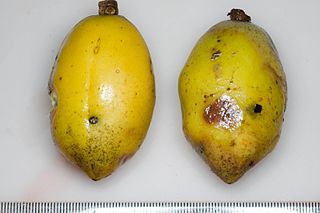
Glycydendron is a genus of plants, under the family Euphorbiaceae first described as a genus in 1922. It is native to South America.
- Glycydendron amazonicumDucke - French Guinea, Suriname, Guyana, Ecuador, Peru, Bolivia, northwestern Brazil, possibly Colombia
- Glycydendron espiritosantenseKuhlm, - State of Espírito Santo in Brazil
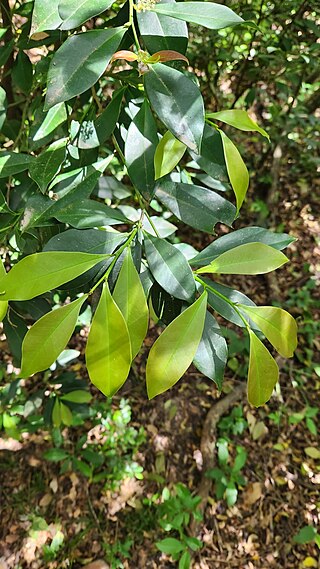
Actinostemon is a plant genus of the family Euphorbiaceae first described as a genus in 1841. It is native to South America, Central America, and the West Indies.
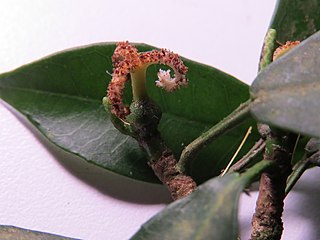
Algernonia is a plant genus of the family Euphorbiaceae first described as a genus in 1858. It is native to Peru and Brazil.
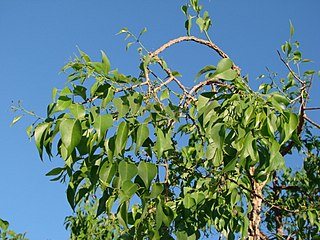
Agonandra is a genus of plants in the family Opiliaceae described as a genus in 1862.

Campomanesia is a genus in the family Myrtaceae described as a genus in 1794. It is native to South America and Trinidad.

Plinia is a genus of flowering plants in the myrtle family, Myrtaceae described by Linnaeus in 1753. It is native to Central and South America as well as the West Indies.

Calycolpus is a genus of the botanical family Myrtaceae, first described as a genus in 1856. It is native to the South America, Central America, and the West Indies.
Calycorectes is a genus of plant in family Myrtaceae first described as a genus in 1856. It is native to South America, southern Mexico, and the Dominican Republic.
Neomitranthes is a genus of plant in family Myrtaceae first described as a genus in 1977. The entire genus is endemic to Brazil.

Bixa is a genus of plants in the family Bixaceae. It is native to Mexico, Central America, Caribbean, and South America, and naturalized in other places.
Myrteola is a plant genus in the Myrtaceae described as a genus in 1856. It is native to South America and the Falkland Islands.

Tinantia is a genus of plants in the Commelinaceae, first described in 1839. They are commonly called widow's tears or false dayflowers due to their resemblance of the closely related true dayflowers of the genus Commelina. Tinantia is native to North and South America from Texas + Hispaniola to Argentina, with a center of diversity from Mexico to Nicaragua. Tinantia pringlei, an alpine native of Mexico, is grown as an ornamental in temperate areas and is also a common greenhouse weed.

Ischnosiphon is a genus of plants native to Central America, South America, Trinidad and the Lesser Antilles. It was first described as a genus in 1859.
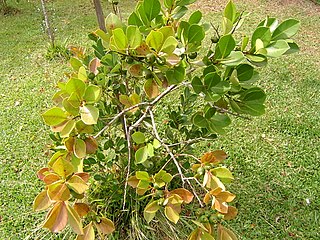
Mosiera is a genus of shrubs and small trees in the family Myrtaceae, first described as a genus in 1933. It is native to Mexico, Guatemala, the West Indies, Brazil, and Florida.

Siphoneugena is a genus of the botanical family Myrtaceae, first described as a genus in 1856. It is native to Central and South America as well as the West Indies.

















